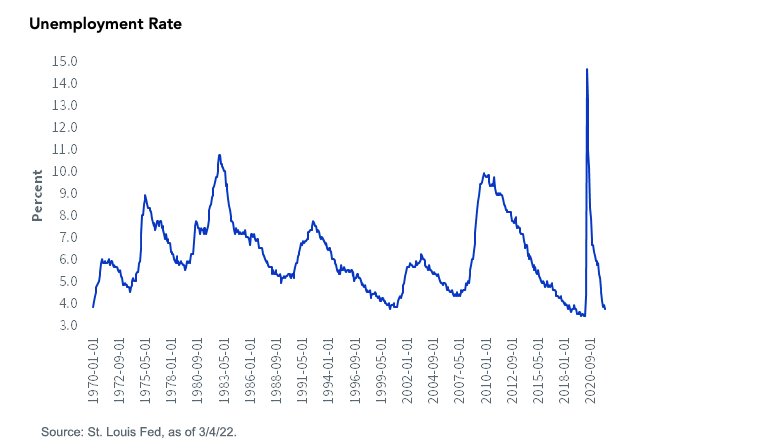By Kevin Flanagan, Head of Fixed Income Strategy
On the domestic economic front, I’ve received a lot of questions lately about the prospects for ‘stagflation.’ By definition, stagflation is a period of weak growth, if any, combined with high inflation.
Based on the economic data available at this time, I would surmise that the ‘inflation’ part of this term is certainly on point, but I don’t see any visible signs of the ‘stag’ component.
To look at the U.S. economy’s last actual bout of stagflation, we need to go back to the 1970s. That brings to mind another key component to this economic condition: high unemployment.
During the entire decade of the ‘70s, the average jobless rate came in at 6.2%, peaking at 9% in 1975 (see below).

After looking at the February Employment Situation report, it is readily apparent the labor market backdrop here in early 2022 is light years away from the 1970s average. Indeed, the jobless rate fell to 3.8%, which is not only an historically low figure, but it brings the level back to the roughly 3.5%–4% range of before the pandemic (see above).
This drop below the 4% threshold was the by-product of two very healthy developments: the civilian labor force and employment measures rising. In fact, the underlying employment data suggest that a jobless rate below 3.5% could very well be in the offing in the months ahead, certainly not an indicator that suggests a noteworthy growth slowdown is anywhere near imminent.
Historically low unemployment combined with solid wage gains should provide support for consumer spending and the economy as a whole. In addition, household balance sheets appear to be rather healthy as well, by any standard measure.
That’s not to say I’m downplaying the negative tax effects from higher energy prices, but it is important to note these positive offsets from the consumer side of the ledger.
Fed Policy
That brings us to the Fed, where the concern is that the policy makers will raise rates too high and act as a catalyst for slower growth.
However, keep in mind, the Fed’s starting point is beginning the process of removing emergency policy measures, where Fed Funds are essentially at zero and their balance sheet stands at an incredible $9 trillion.
Even if Powell & Co. were to raise rates a quarter point at each of the remaining FOMC meetings this year, the Fed Funds range would still be at only 1.75%–2%. During the 1970s, the effective Fed Funds Rate peaked out at over 13%!
Conclusion
In other words, the Fed has a long runway for tightening before monetary policy could be considered in restrictive territory.
The Chairman pro tempore made it very clear at last week’s Semiannual Monetary Policy testimony that “the Fed needs to be nimble and alert” in this difficult environment.
This post first appeared on March 9 on the WisdomTree blog.
Photo Credit: 401 (k) 2012 via Flickr Creative Commons
Disclosure
There are risks involved with investing, including possible loss of principal. Foreign investing involves currency, political and economic risk. Funds focusing on a single country, sector and/or funds that emphasize investments in smaller companies may experience greater price volatility. Investments in emerging markets, currency, fixed income and alternative investments include additional risks. Please see the prospectus for discussion of risks.
Past performance is not indicative of future results. This material contains the opinions of the author, which are subject to change, and should not to be considered or interpreted as a recommendation to participate in any particular trading strategy, or deemed to be an offer or sale of any investment product and it should not be relied on as such. There is no guarantee that any strategies discussed will work under all market conditions. This material represents an assessment of the market environment at a specific time and is not intended to be a forecast of future events or a guarantee of future results. This material should not be relied upon as research or investment advice regarding any security in particular. The user of this information assumes the entire risk of any use made of the information provided herein. Neither WisdomTree nor its affiliates, nor Foreside Fund Services, LLC, or its affiliates provide tax or legal advice. Investors seeking tax or legal advice should consult their tax or legal advisor. Unless expressly stated otherwise the opinions, interpretations or findings expressed herein do not necessarily represent the views of WisdomTree or any of its affiliates.



